Here we are, looking down the barrel of another stretch of at-home learning. We always knew that it was likely not “if” but “when” we’d be back here, but the fact that many districts are announcing remote learning from day one has caught us all by surprise. Worn down from an already long stretch of stay-at-home learning, it’s understandable for parents to feel overwhelmed or daunted by the prospect.
 The good news? We’ve done it once, we know how to adjust this time around. The bad news? We know just how hard it can be to support your kids as they learn, especially for those who are also trying to work. Over and over again we’ve heard this frustration from parents, especially those with young children who may need support. So, as former special education teachers who worked with young students, we thought we’d put together a list of strategies that will support all learners as you set up an at-home learning environment for your students. Whether you already know your childcare center or school is remote, or you’re wanting to be ready if schools close again, we hope you find this helpful.
The good news? We’ve done it once, we know how to adjust this time around. The bad news? We know just how hard it can be to support your kids as they learn, especially for those who are also trying to work. Over and over again we’ve heard this frustration from parents, especially those with young children who may need support. So, as former special education teachers who worked with young students, we thought we’d put together a list of strategies that will support all learners as you set up an at-home learning environment for your students. Whether you already know your childcare center or school is remote, or you’re wanting to be ready if schools close again, we hope you find this helpful.
Create a space for learning
Our brains associate spaces with activities so setting up a physical space that’s dedicated to learning will help you be successful learning at home. This doesn’t have to mean buying all new furniture. Instead, just repurpose a corner of your home to serve as “school” for your student - it could be as simple as a placemat at the table you put out to signal that we are at school now. Give your learner ownership over the space by allowing them to decorate it. Consider doing a tour of the working spaces where you and your child will work to make it exciting! Make sure the space has plenty of lighting and a clearly posted schedule and/or task list for the day. You might also consider building a comfy corner, hamper, or box for your student to work in that can serve as a reading nook, morning meeting corner, or quiet time space.
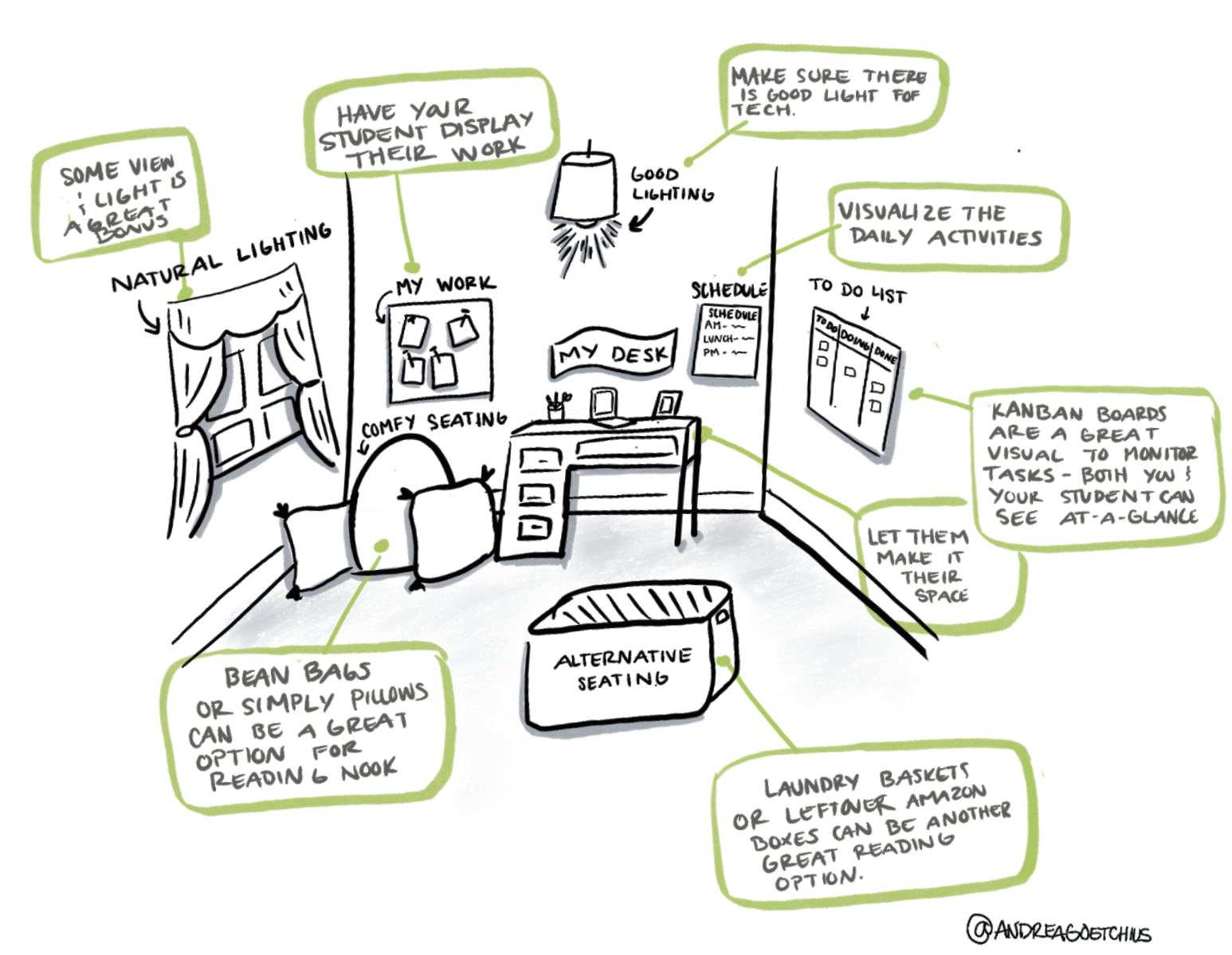
Use predictable scheduling
Every day, start out with a predictable routine that signals that learning time is starting. Many classrooms do this by starting off with a welcome song (for ideas, check this list). Then, reinforce some basic skills by doing calendar math: On a simple piece of poster board, use post-its or taped pieces of paper that review daily what day of the week it is, the date, and allow students to check in with how they’re feeling. Then, use visual schedules to go over the plan for the day.
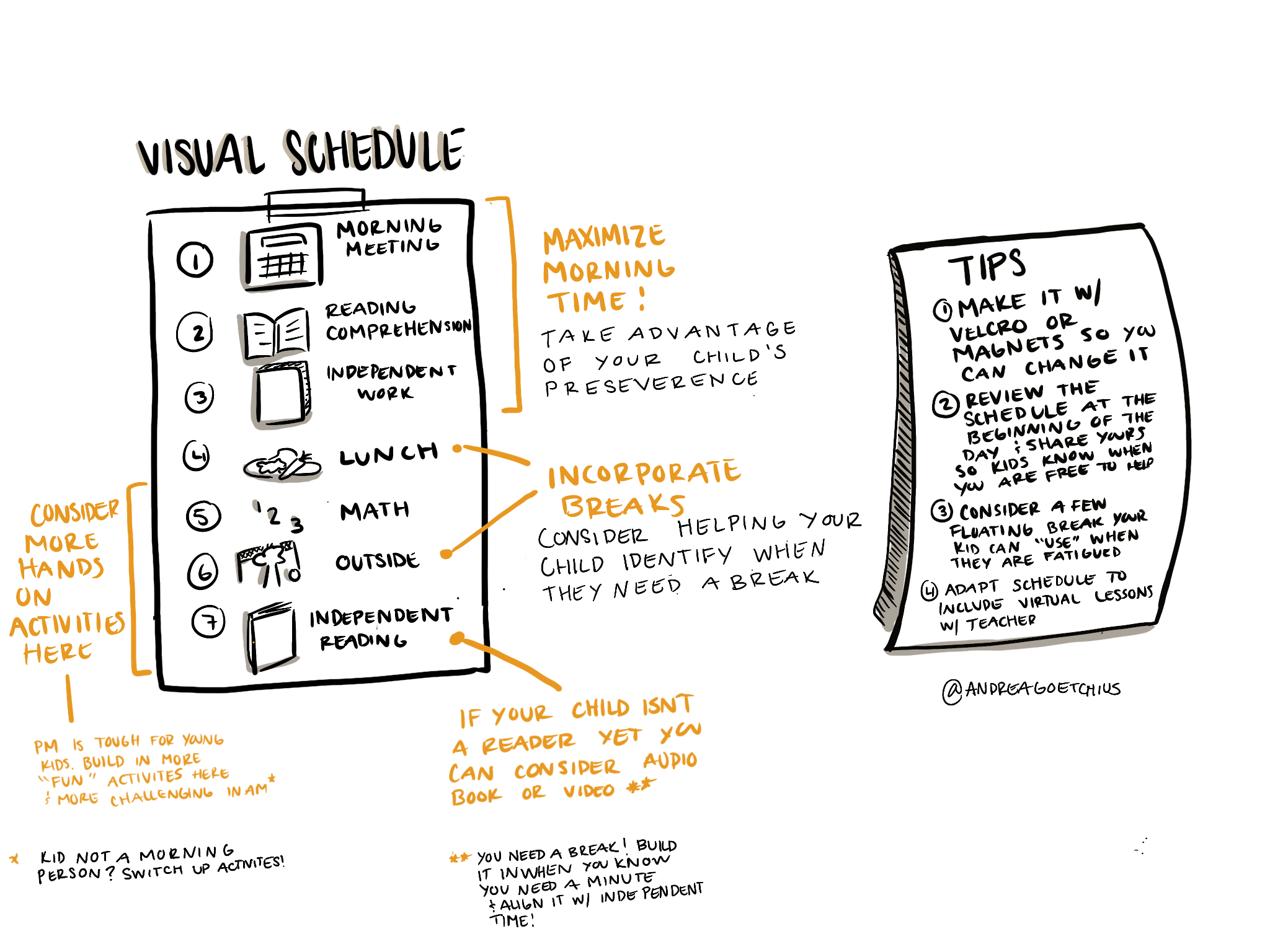
Predictability is key for your young learners. Try to keep reading time in the morning and math after lunch, for example. However, you could let your learner have some ownership over when to do other activities like outside time, music breaks, and more.
If you have multiple children at home with different learning schedules and online/remote learning requirements, create a space to house all of your schedules and consider color coding to help you and your learners understand how the pieces are going to work together.
Build routines that foster independence
As a parent, I often find it faster/easier to just do things for my kid. He wants to help, really he does, but, well-intentioned as he may be, he made the thirty-second chore, feeding the dogs, into a bring your own mop affair. Lesson learned: if I work with him intentionally a few days in a row, my son has actually gotten pretty effective at this simple chore. However, I had to release some control, embrace the chaos, and let him learn. I realized that he took over as much as I let him take over. Routines can support student ownership for younger learners. As you establish your morning routine, let students take the lead on the welcome song or calendar math. Spend the first few weeks establishing routines and procedures and then gradually release control to your child.
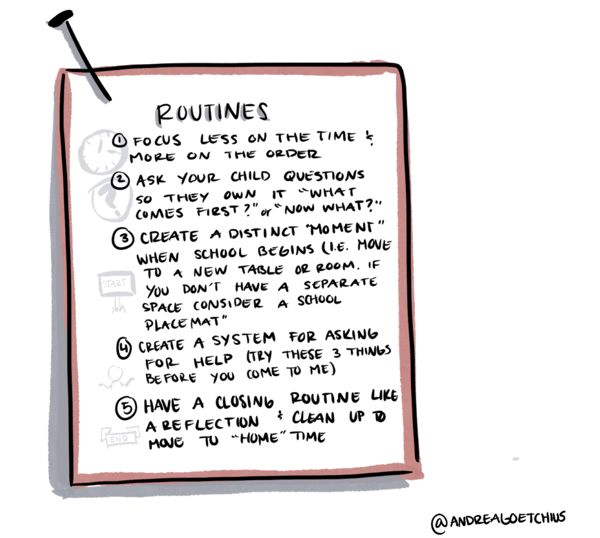
Consider explicitly teaching your student what they can do when learning is hard. How do they get help? What should they try before asking you? Talking to your learner about this more explicitly can help them persevere when learning gets tough. To introduce this, when they bring a problem to you, turn it back on them, for example: what do you think you could do to find that assignment? Celebrate their attempts to solve a problem independently and give them space to fix things on their own. It might take a bit longer at first, but this is a skill that will serve them well in the long run.
To help your student get organized, make a daily kanban board of tasks. This simple chart puts tasks into three categories: to do, doing, and done. Set this up at the start of each class for your student and show them how to take one task and move it from “to do” to “doing” and, eventually, "done." Then ask them about each of the things they did.
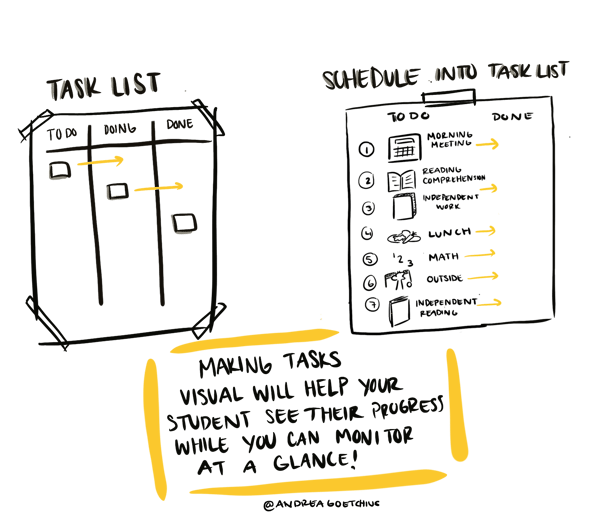
Encourage your children to engage in independent work or play
Studies show that young children benefit from independent play. If we take that a step further and look at the Montessori model of school, children like to learn independently and enjoy imaginative play where they pretend to be, you guessed it, adults! Consider rewards for independence and accomplishing big tasks that leverage their desire to be a “big kid.”
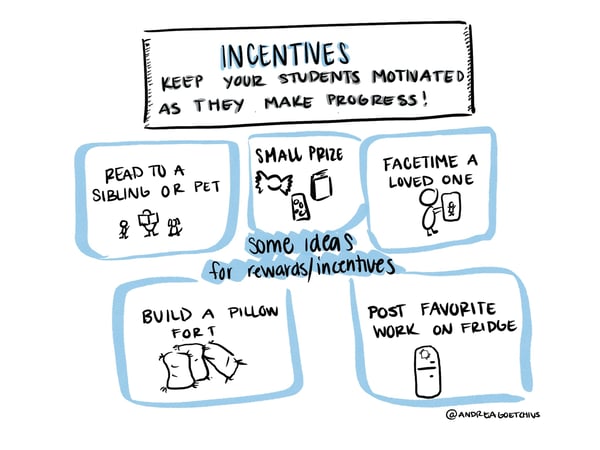
In a recent story, NPR’s Lifekit explains how to build the independent play muscle. At this particular time, many parents heard “at-home school” and started planning every minute of the day for their children (myself included). Children learned to expect that - when they don’t know what to do, they look to their parent or caregiver for entertainment rather than finding their own activity. However, it’s not sustainable to do this for our kids long term and it’s important for them to be able to play independently, solve problems, and self-direct. To get started building in longer stretches of independent play, consider using the 15/45 rule. Give your child 15 focused minutes of attention. Then, set them up with an independent activity and let them engage in self-directed play for 45 minutes. It won’t happen seamlessly right away, but stick with it and you may be able to get longer stretches of work time in before you know it.
Take off the pressure

I know this is a lot. Know that no one expects you to be a teacher and no one expects you to do it all. One way to prioritize what you do with your learner is to look at the readiness standards for your student’s age group. While there are a lot of things you can possibly work on, you might ask your teacher which one or two to focus on. Don’t worry about tackling all of them, just do what you can, as you can. For children under five, know that there isn’t more than an hour of instruction that you *have* to do. Students this age need more time for play and exploration. Some low-prep activities that can occupy your student and engage their mind:
- Find all the objects in this room that are red
- Sensory letter tracing in bags of paint, a paper plate with salt on it, etc.
- Matching shoes/socks
Supporting younger siblings
Many of you are not just helping your school-aged children and managing your own workload but also trying to keep your babies and toddlers entertained, essentially doing three jobs at once! And, if you have ever been around a toddler you know that focusing on one activity for more than 15- 20 minutes is not their strong suit. Consider a menu of activities your learners can do independently. Try following an account like @busytoddler and remember that at the end of the day the developmentally appropriate activities for preschool-aged children are simple like:
- Count to 30
- Cut and paste
- Trace letters and spell their name
- Alphabet (lowercase, uppercase, and sounds)
- Identify colors and shapes (Learn more at NAEYC)
And don’t be afraid to cut yourself a little slack; iPad or movie time might be the right call for everyone’s sanity. And remember you are doing the best you can in the middle of global pandemic. We are in this together so let us know what you try by tagging us on twitter: @edelements @AndreaGoetchius @LKMilam
More Virtual Learning reading
Blog: Adaptations for Flexible Learning
Blog: What Do Students Need Right Now?
Blog: 7 Strategies to Develop Student Executive Functioning Skills for Remote Learning
Blog: Distance Learning Requires a Student-Centered Approach
Blog: Addressing Schooling Loss in Schools With These Four Strategies
Blog: Shifts in Professional Learning: more microlearning and virtual courses



